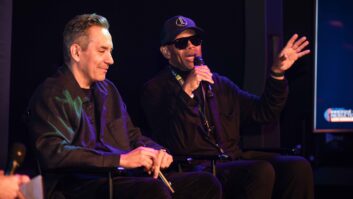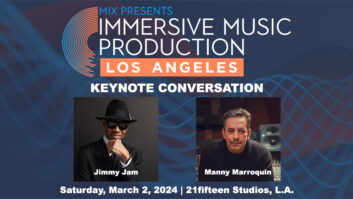With a new record, The Madness, released in March, hard rock ‘supergroup’ Art of Anarchy embarks on a new road chock full of tour dates, fresh material and a new lead singer. An amalgamation of five accomplished, individual personalities, Art of Anarchy’s raw synergies are clearly expressed on its new record, which features the skillful crooning of former Creed lead singer Scott Stapp along with rock veterans Ron ‘Bumblefoot’ Thal (Guns N’ Roses), John Moyer (Disturbed) and brothers Jon and Vince Votta. Pro Sound News spoke to Bumblefoot, who described how an open mind and the right ingredients can imbue a lasting result—with a unique sonic edge.
On working the kinks out:
Right now, we are finishing up our first tour together and it is the first time being on the road. We are in a bus together and are doing what a band should be doing. With each and every show, we are getting all the kinks out and it has really become a well-oiled machine. At first, you don’t know how it’s going to go when everyone gets on the tour bus, but it has been well beyond our expectations. It has been full of laughter, fun and without drama. This has probably been the best tour of my entire life.
On early origins:
I met Jon and Vince Votta, the guitarist and drummer of the group, 20 years ago. I had a studio in New York and they had a band nearby and came in to check it out. We clicked and I started recording them. At first, it was just myself engineering, and then they would bring in a producer to help them career-wise. I saw how the producer would try to change them instead of doing what I feel producers should do: bring out the best of the artist and make them an enhanced version of themselves. Eventually I started producing the things they were doing, in addition to engineering. A few years later, it was the three of us making the music, and the idea was to get different singers for different songs. Eventually, Scott Weiland ended up singing and John Moyer also joined, and it started to evolve into something more. Sadly, Scott Weiland distanced himself from it all and didn’t want to be involved. So we asked ourselves ‘Where do we go from here?’
On the new chemistry:
Once we met up with Scott Stapp in August of 2015, we knew we had an absolute fit. We just jammed with no plan in mind and the chemistry was there. The following month, the five of us got into a room and we built the current band from the ground up. We spent about a week and a half together, day and night, and I had my little Focusrite two input converter and a 58 on the floor to capture the room. One of us would play a riff, then someone else would play a take on what might complement that. Shortly after that, we started tracking drums and guitar parts, getting into arrangements and feeling out the grooves. Then we got with Scott for a good two months and the songs really came together. To me, the song doesn’t happen until the vocals are there, and that’s when you start rethinking arrangements, sounds, dynamics and structure.
On recording on instincts:
When we go into the studio, it is usually an eight-hour day. I am in the chair for whatever goes on from the beginning until the end, until the master is submitted to the label. While we are in the studio, it is not like there is a guitar in your hand and you are saying ‘What should come next?’ It is more like you are using your instincts as a listener and you have a tension, like you are in labor. You are trying to feel what comes next and turn it into music. Scott Stapp helped give us the structure we needed; we were able to start from the very beginning and do it the right way.
On combined ingredients:
For this record, we didn’t have a plan in mind when we started. It was just five people, each with their own musical personalities. The salt continued to be salt, the pepper continued to be pepper, and the cayenne continued to be cayenne. When you put all of our personalities together, you have something unique that you won’t find in any other dish. With Scott, you are going to have melodies and messages in his lyrics that are just so personal and relatable. With the Vottas, you are going to have this attack in the way they play. Then you have Moyer, who brings this modern, edgy rock metal groove thing. My contribution is a little left of center with my weird guitar stuff, and melodies that surround Scott.
On bringing out emotion:
From a producer’s perspective, the first step in recording is to know the artist and to find out what makes them comfortable, because it is going to be different for everybody. Your goal is to capture not just the surface performance, but their emotion, because that is what people are going to feel. As a producer, I believe you shouldn’t try to change artists or try to make something they are not; authenticity is the most important thing and listeners know this. There is a human spirit that goes along with every performance—and if it is not there, it is shit.
On keeping the energy:
I think our immediate goals are to do more shows—to get into as many venues as possible and make that personal connection with everybody. But then again, we make plans and God laughs, so we need to take this a step at a time. As a rock band, the live performance is what it is all about. If I didn’t hear the energy in Kiss Alive that I heard when I was five years old, I would be an accountant right now.
Jacques Sonyieux is a devout explorer of recording studios and the artists that occasionally inhabit them. Please send any tips or feedback to Jacques at: jacquessonyieux@gmail.com.







